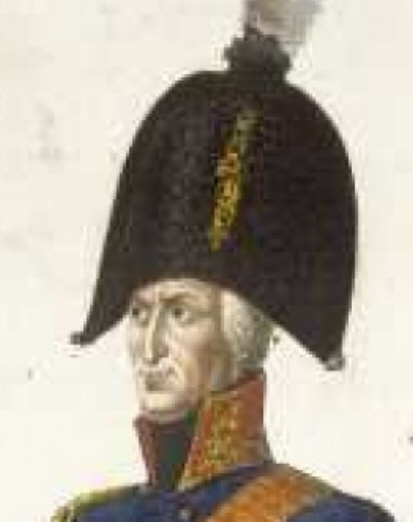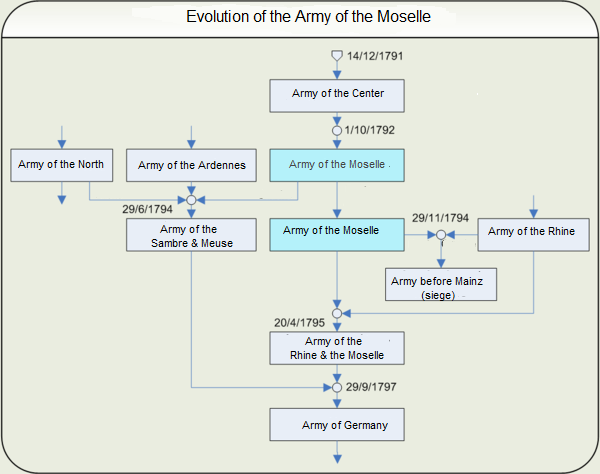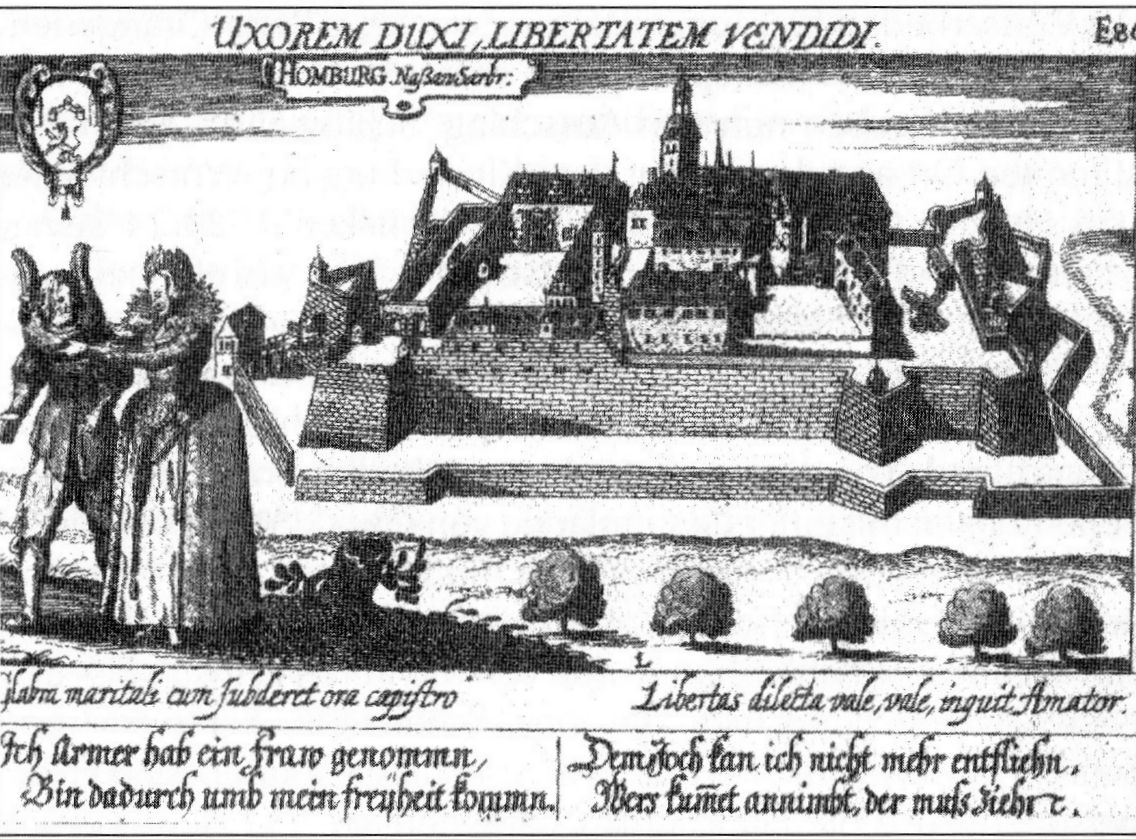|
Battle Of Biesingen
The Battle of Biesingen was a battle of the War of the First Coalition on 17 November 1793 at Biesingen, now a district of Blieskastel. It occurred between a Prussian force under General Friedrich Adolf von Kalckreuth and a French one under General Louis-Lazare Hoche, ending in a Prussian victory. Course The French Army of the Moselle set off from its camp on the Saar in three columns on the morning of 17 November. Whilst two of the columns continued to Tholey and St. Ingbert, the third and strongest column turned towards Biesingen, where von Kalckreuth blocked the route between Biesingen and Blieskastel. The battle opened with heavy French artillery fire against the Prussian centre on the Hilscheider heights. At the same time 800 French infantry had crossed the Blies at Blieskastel to attack the Prussian right flank, but thanks to a patrol this attempt to flank the Prussians failed. They held out until reinforcements arrived and forced the French to retreat. In an attempt ... [...More Info...] [...Related Items...] OR: [Wikipedia] [Google] [Baidu] |
War Of The First Coalition
The War of the First Coalition (french: Guerre de la Première Coalition) was a set of wars that several European powers fought between 1792 and 1797 initially against the Kingdom of France (1791-92), constitutional Kingdom of France and then the French First Republic, French Republic that succeeded it. They were only loosely allied and fought without much apparent coordination or agreement; each power had its eye on a different part of France it wanted to appropriate after a French defeat, which never occurred. Noah Shusterman – ''De Franse Revolutie (The French Revolution).'' Veen Media, Amsterdam, 2015. (Translation of: ''The French Revolution. Faith, Desire, and Politics.'' Routledge, London/New York, 2014.) Chapter 7 (p. 271–312) : The federalist revolts, the Vendée and the beginning of the Terror (summer–fall 1793). Relations between the French revolutionaries and neighbouring monarchies had deteriorated following the Declaration of Pillnitz in August 1791. Eight mo ... [...More Info...] [...Related Items...] OR: [Wikipedia] [Google] [Baidu] |
First French Republic
In the history of France, the First Republic (french: Première République), sometimes referred to in historiography as Revolutionary France, and officially the French Republic (french: République française), was founded on 21 September 1792 during the French Revolution. The First Republic lasted until the declaration of the First Empire on 18 May 1804 under Napoléon Bonaparte, although the form of the government changed several times. This period was characterized by the fall of the monarchy, the establishment of the National Convention and the Reign of Terror, the Thermidorian Reaction and the founding of the Directory, and, finally, the creation of the Consulate and Napoleon's rise to power. End of the monarchy in France Under the Legislative Assembly, which was in power before the proclamation of the First Republic, France was engaged in war with Prussia and Austria. In July 1792, the Duke of Brunswick, commanding general of the Austro–Prussian Army, issued his Bru ... [...More Info...] [...Related Items...] OR: [Wikipedia] [Google] [Baidu] |
Kingdom Of Prussia
The Kingdom of Prussia (german: Königreich Preußen, ) was a German kingdom that constituted the state of Prussia between 1701 and 1918.Marriott, J. A. R., and Charles Grant Robertson. ''The Evolution of Prussia, the Making of an Empire''. Rev. ed. Oxford: Clarendon Press, 1946. It was the driving force behind the unification of Germany in 1871 and was the leading state of the German Empire until its dissolution in 1918. Although it took its name from the region called Prussia, it was based in the Margraviate of Brandenburg. Its capital was Berlin. The kings of Prussia were from the House of Hohenzollern. Brandenburg-Prussia, predecessor of the kingdom, became a military power under Frederick William, Elector of Brandenburg, known as "The Great Elector". As a kingdom, Prussia continued its rise to power, especially during the reign of Frederick II, more commonly known as Frederick the Great, who was the third son of Frederick William I.Horn, D. B. "The Youth of Frederick ... [...More Info...] [...Related Items...] OR: [Wikipedia] [Google] [Baidu] |
Louis-Lazare Hoche
Louis Lazare Hoche (; 24 June 1768 – 19 September 1797) was a French military leader of the French Revolutionary Wars. He won a victory over Royalist forces in Brittany. His surname is one of the names inscribed under the Arc de Triomphe, on Column 3. Richard Holmes describes him as "quick-thinking, stern, and ruthless... a general of real talent whose early death was a loss to France." Early life Hoche was born on 24 June 1768 in the village of Montreuil, today part of Versailles, to Anne Merlière and Louis Hoche, a stable servant of the king. His mother died when he was two years old, and Hoche was mostly raised by an aunt, who was a fruit-seller in Montreuil, and was educated by the Abbé Merlière, his maternal uncle, parish priest of Saint-Germain-en-Laye, who arranged for Hoche to become a choirboy at his church. Early career In 1782, Hoche began working as an aide at the royal stables, but soon left in order to join the Army. He entered the French Guards reg ... [...More Info...] [...Related Items...] OR: [Wikipedia] [Google] [Baidu] |
Friedrich Adolf Von Kalckreuth
Friedrich Adolf Graf von Kalckreuth (22 February 1737 – 10 June 1818) was a Prussian Generalfeldmarschall. Kalkreuth was born in Sotterhausen near Sangerhausen. He entered the regiment of Gardes du Corps in 1752, and in 1758 was adjutant or '' aide de camp'' to Frederick the Great's brother, Prince Henry, with whom he served throughout the later stages of the Seven Years' War. He won special distinction at the battle of Freiberg (29 September 1762), for which Frederick promoted him major. Personal differences with Prince Henry severed their connection in 1766, and for many years Kalckreuth lived in comparative retirement. He participated in the War of the Bavarian Succession as a colonel, and on the accession of Frederick William II was restored to favour. He greatly distinguished himself as a major-general in the invasion of the Netherlands in 1787, and by 1792 had become count and lieutenant-general. Under the Duke of Brunswick, he took a conspicuous part in the camp ... [...More Info...] [...Related Items...] OR: [Wikipedia] [Google] [Baidu] |
Blieskastel
Blieskastel () is a city in the Saarpfalz (Saar-Palatinate) district, in Saarland, Germany which is divided into villages. It is situated on the river Blies, approximately southwest of Homburg (Saar), west of Zweibrücken, and east of Saarbrücken. Geography Blieskastel is the capital of the Bliesgau and is located in the center of the Bliesgau Biosphere Reserve. The city borders on the cities of Homburg, St. Ingbert, Zweibrücken and Hornbach, and the municipalities of Gersheim, Kirkel and Mandelbachtal. The Blies flows by Blieskastel. The districts of Niederwürzbach, Lautzkirchen and Alschbach are located in the Sankt Ingbert-Kirkeler forest area. Climate The annual rainfall is and is in the upper third. 70% indicate low values. The driest month is April. It rains most in December. Organization The city of Blieskastel consists of Blieskastel-Mitte and 14 districts. Alphabetically these are Altheim, Aßweiler, Ballweiler, Bierbach an der Blies, Biesingen, Blickweiler, Böc ... [...More Info...] [...Related Items...] OR: [Wikipedia] [Google] [Baidu] |
Army Of The Moselle
The Army of the Moselle (''Armée de la Moselle'') was a French Revolutionary Army from 1791 through 1795. It was first known as the ''Army of the Centre'' and it fought at Valmy. In October 1792 it was renamed and subsequently fought at Trier, First Arlon, Biesingen, Kaiserslautern, Froeschwiller and Second Wissembourg. In the spring of 1794 the left wing was detached and fought at Second Arlon, Lambusart and Fleurus before being absorbed by the ''Army of Sambre-et-Meuse''. In late 1794, the army captured Trier and initiated the Siege of Luxembourg. During the siege, the army was discontinued and its divisions were assigned to other armies. History Originally known as the ''Army of the Centre'', it was renamed by decree of the National Convention on 1 October 1792 and kept under that name in the decrees of 1 March and 30 April 1793. By the decree of 29 June 1794 its left wing joined with the ''Army of the Ardennes'' and the right wing of the ''Army of the North'' to form the ... [...More Info...] [...Related Items...] OR: [Wikipedia] [Google] [Baidu] |
Saar (river)
The Saar (; french: Sarre ) is a river in northeastern France and western Germany, and a right tributary of the Moselle. It rises in the Vosges mountains on the border of Alsace and Lorraine and flows northwards into the Moselle near Trier. It has two headstreams (the ''Sarre Rouge'' and ''Sarre Blanche'', which join in Lorquin), that both start near Mont Donon, the highest peak of the northern Vosges. After (129 kilometres; 80 miles in France and on the French-German border, and 117 kilometres; 73 miles in Germany) the Saar flows into the Moselle at Konz (Rhineland-Palatinate) between Trier and the Luxembourg border. It has a catchment area of . The Saar flows through the following departments of France, states of Germany and towns: * Moselle (F): Abreschviller (Sarre Rouge), Lorquin, Sarrebourg, Fénétrange *Bas-Rhin (F): Sarre-Union * Moselle (F): Sarralbe, Sarreguemines *Saarland (D): Saarbrücken, Völklingen, Wadgassen, Bous, Saarlouis, Dillingen, Merz ... [...More Info...] [...Related Items...] OR: [Wikipedia] [Google] [Baidu] |
Tholey
Tholey () is a municipality in the district of Sankt Wendel, in Saarland, Germany. It is situated approximately west of Sankt Wendel, and north of Saarbrücken. History Local history The first traces of settlement in the area of today's Tholey go back to the Celts. Multiple archaeological finds show an extended occupation by the Romans. In medieval times, much of today's Saarland was tributary to the Abbey of Tholey. To protect the abbey a castle was constructed on the nearby Schaumberg. Tholey was under control of Lorraine and of the Archbishop Prince-elector of Trier. Tholey is located on the edge of the Schaumberg, the highest mountain in Saarland and the Hunsrück range. The name has been derived from the Celtic ''*dol(wo)'' meaning "outstanding", a derivation found also in the name of the neighboring Dollberg hill and in Lorelei (originally Dorley), related to the German ''toll'' or ''doll''. " Ley" is a Celtic and Germanic word meaning "cliffs." Tholey is thus "the vi ... [...More Info...] [...Related Items...] OR: [Wikipedia] [Google] [Baidu] |
Wolfersheim
Wolfersheim is a village in the municipality of Blieskastel in the region Bliesgau (Saarland, Germany). Geography The village is situated on the east hillside of Kalbenberg, right of the river Blies. The church (its origins date back to the 14th century) is the center of the village. In front of the church is one of the many fountains that can be found throughout the village, all beautifully decorated with stone sculptures. The village has many chestnut and walnut trees and well as mixed orchard grasslands. History On the mountain ridge close to Wolfersheim a group of graves were found that date back from the Hallstatt culture (800 - 500 AD). Wolfersheim was first documented in 1274 and was a settlement of a Frankish man Wolfhari. The main road of the village is still named after Wolfhari. In the late Middle Ages, the village belonged to the monasteries of Hornbach, Gräfinthal and Wadgassen. Since 1453, Stephen, Count Palatine of Simmern-Zweibrücken became the regent. In ... [...More Info...] [...Related Items...] OR: [Wikipedia] [Google] [Baidu] |
Homburg, Saarland
Homburg (; french: Hombourg, pfl, Humborch) is a town in Saarland, Germany and the administrative seat of the Saarpfalz district. With a population of 43,029 inhabitants (2022), it is the third largest town in the state. The city offers over 30,000 workplaces. The medical department of the University of Saarland is situated here. The city is also home to the Karlsberg beer brewery. Major employers include Robert Bosch GmbH, Schaeffler Group and Michelin. Geography Homburg is located in the northern part of the Saarpfalz district, bordering Rhineland-Palatinate. It is 16 km from Neunkirchen and 36 km from Saarbrücken. The city districts are situated in the Blies valley or on its tributaries Erbach, Lambsbach and Schwarzbach. Homburg is composed of Homburg center and nine city districts: Beeden, Bruchhof-Sanddorf, Einöd, Erbach, Jägersburg, Kirrberg, Reiskirchen, Schwarzenbach and Wörschweiler. Einöd includes: Einöd, Ingweiler and Schwarzenacker; ... [...More Info...] [...Related Items...] OR: [Wikipedia] [Google] [Baidu] |
Kaiserslautern
Kaiserslautern (; Palatinate German: ''Lautre'') is a city in southwest Germany, located in the state of Rhineland-Palatinate at the edge of the Palatinate Forest. The historic centre dates to the 9th century. It is from Paris, from Frankfurt am Main, 666 kilometers (414 miles) from Berlin, and from Luxembourg. Kaiserslautern is home to about 100,000 people. Additionally, approximately 45,000 NATO military personnel are based in the city and its surrounding district ('' Landkreis Kaiserslautern''), contributing approximately US$1 billion annually to the local economy. History and demographics Prehistoric settlement in the area of what is now Kaiserslautern has been traced to at least 800 BC. Some 2,500-year-old Celtic tombs were uncovered at Miesau, a town about west of Kaiserslautern. The recovered relics are now in the Museum for Palatinate History at Speyer. Medieval period Kaiserslautern received its name from the favourite hunting retreat of Holy Roman Emperor F ... [...More Info...] [...Related Items...] OR: [Wikipedia] [Google] [Baidu] |







.jpg)